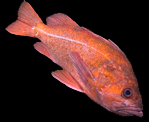
Giant kelp, Macrocystis sp.
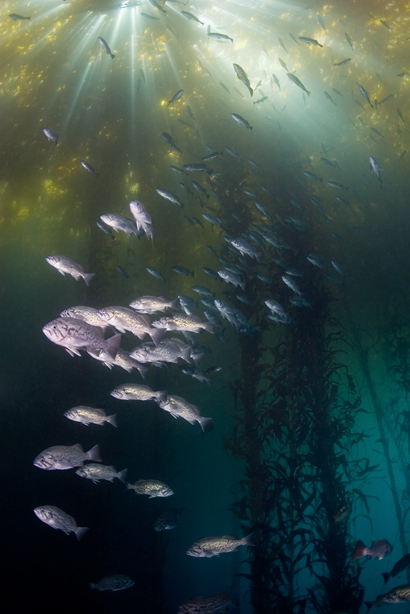
At depth, stands of giant kelp (Macrocystis sp.) are sparse. On the
water's surface, however, their lush canopy may permit only a few beams of
sunlight to pass. The surreal sensation of swimming just beneath the canopy as
these always dancing and occasionally blinding rays contrast with the shadows of
lurking blue rockfish (Sebastes mystinus) enchants almost all who
experience it. Environmental activist and long time dive boat captain Ed Cooper
was so taken with these lights that he named them "God beams". It's a fitting
appellation for one of many dive experiences that photograph poorly. This is
easily the closest I've come to capturing the feeling, but it lacks the sense of
immersion that comes with the real thing.
"Butterfly House", Carmel Bay, California
July 23, 2005
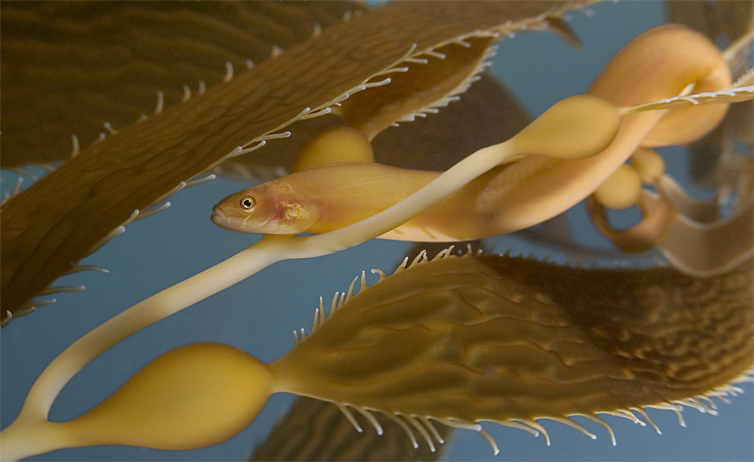
One of the more cryptic denizens of the Monterey bay, kelp gunnels (Ulvicola
sanctaerosae) like this one often display remarkable tail dexterity. If one
is fortunate enough to see this animal at all, it can be quite difficult to
visually trace it from end to end due to it's ability to wrap its tail in
improbably tight coils around stipes of kelp. Small animals that hide in giant
kelp almost universally use the same, very simply, mechanism to deter predators
(and photographers). When discovered, they simply move to the back side of the
stipe on which they're resting. Easy for them, they only have to move a tiny
bit, but a predator/photographer has to move several feet in order to regain
their original view. Of course, what works once, works twice or three times as
well, and you can imagine who usually gets the upper hand in this exchange. I've
tried rolling the kelp's thallus in my fingers to present subjects to the
camera, it doesn't work as well as you might think. The classic solution to this
problem is to place a hand on the backside of the stipe to scare the subject to
the camera side. This works somewhat for wide angle shots if you can get your
scaring hand out of the shot before the subject slips behind the stipe again. It
doesn't work well for macro since it's quite difficult to keep the camera rig
steady with one hand.
"Tanker Reef", Monterey Bay, California
December 4, 2005
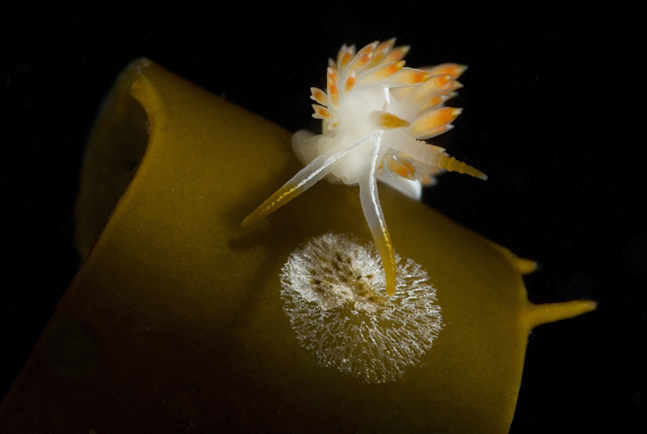
This ant-sized three-lined aeolid (Flabellina trilineata) can move
surprisingly quickly. One doesn't usually think of slugs as particularly speedy,
but if you pick up a camera, you'll likely notice that your shot's composition
changes much faster than you might like. In fact, I was much chagrined by my
first attempt to photograph the beautiful and unusual Aeolidea papillosa.
Simply put, I was, well, outrun -- or, outslithered to be perfectly accurate.
You might notice that there are still no pictures of this animal on the site.
"McAbee Beach", Monterey Bay, California
July 16, 2006
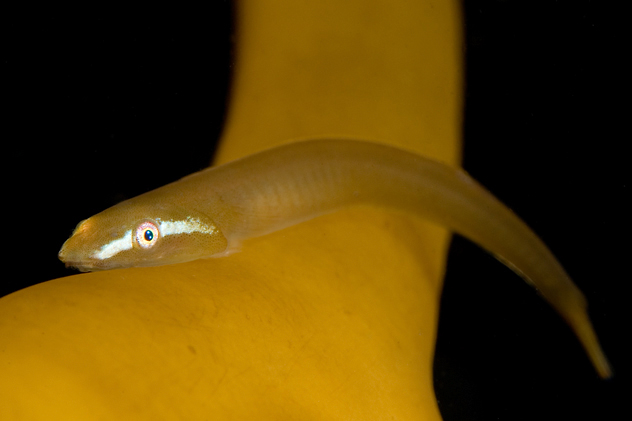
This kelp clingfish (Rimicola muscarum) is, not surprisingly, clinging to
a stipe of giant kelp (Macrocystis sp.). Clingfish are not uncommon, but
have rather cryptic habits and are therefore often overlooked. I spent the
better part of a 150 minute dive shooting this one 3cm fish -- do I know how to
party or what?. As is often the case, I noticed something in the shots once I
got home that I didn't notice during the dive. In this instance, it was that the
subject was changing it's color to match its background. I considered the
possibility that it was only the reflection of strobe light off the background
that created the appearance of different cameleon colors. However, I've now
dismissed this possibility because the color seems to be uniformly applied to
the entire animal, even to parts not backed by something reflective. I've also
found at least one source in the literature that cites the ability to change
color by another member of the genus Rimicola.
"Tanker Reef", Monterey Bay, California
November 11, 2006
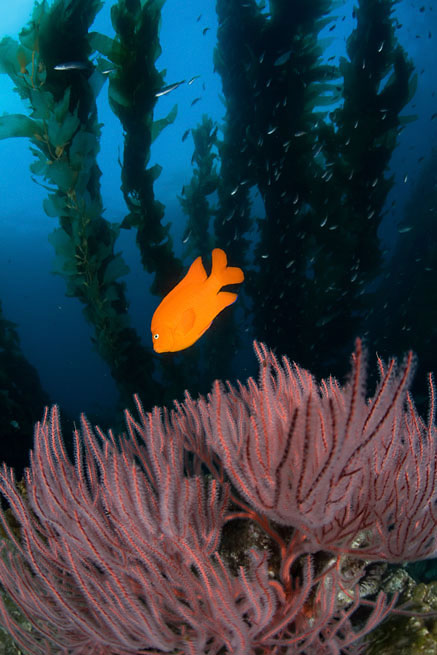
Southern California's most celebrated underwater photo subject, the garibaldi
(Hypsypops rubicundus) is seen here framed by a red gorgonian
(Lophogorgia chilensis) and giant kelp (Macrocystis sp.)
"Eagle Reef", Santa Catalina Island, California
November 24, 2006
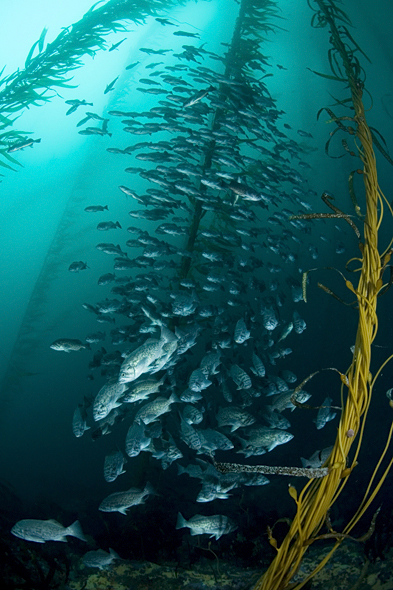
Blue rockfish (Sebastes mystinus) pack into tight schools when currents
are running. Although difficult to photograph, this is most certainly one of my
favorite scenes. The local sea lions seem to like these dense aggregations as
well. Watch such a school for a few minutes and you'll likely see the entire
mass dart toward the reef in fright as one or more of our furry friends
approach. Interestingly enough, the sea lions appear to do this as much for
their own amusement as for any other reason
"Outer Pinnacles", Carmel Bay, California
August 13, 2006
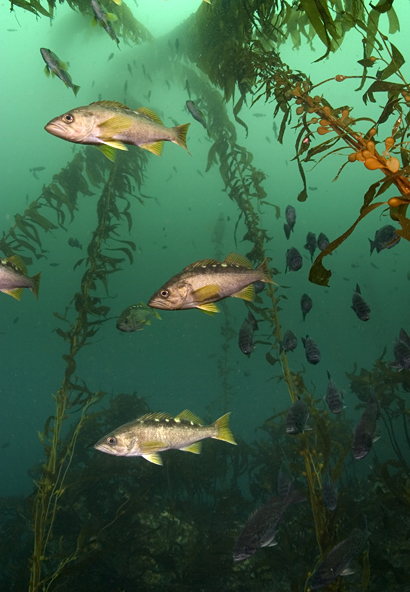
Olive rockfish, (Sebastes serranoides) and blue rockfish (Sebastes
mystinus) often school together. In this photograph, one can see the
boundary between warmer, murky, plankton-rich water above and clearer, colder
water below. Fishwatching enthusiasts should note that olive rockfish appear
nearly identical to yellowtail rockfish (Sebastes flavidus). A high
resolution version of this photograph was sent to rockfish expert, Dr. Milton
Love for identification.
"East Pinnacles", Carmel Bay, California
July 3, 2005
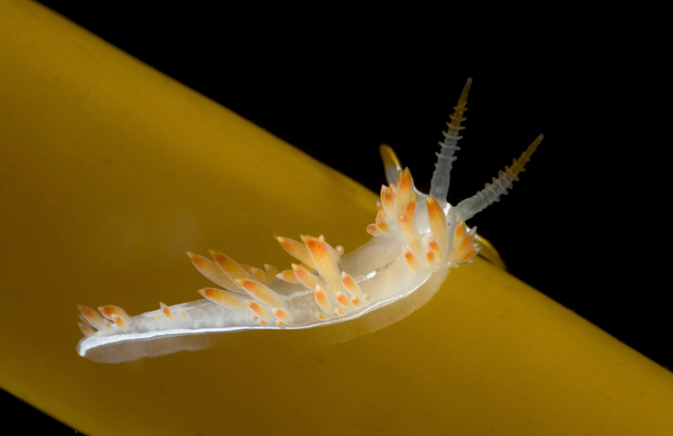
This three-lined aeolid (Flabellina trilineata) is cruising along a stipe
of giant kelp (Macrocystis sp.) in search of prey.
"McAbee Beach", Monterey Bay, California
July 16, 2006
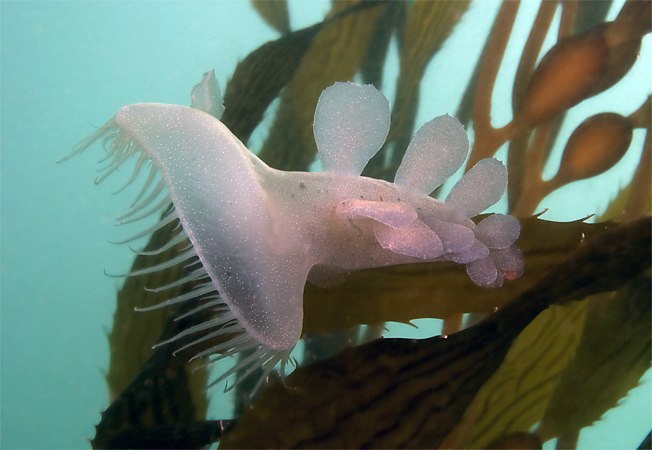
This lion's mane nudibranch (Melibe leonina) is using its massive oral
hood to capture tiny prey that drifts on the passing current.
"Tanker Reef", Monterey Bay, California
January 30, 2005












